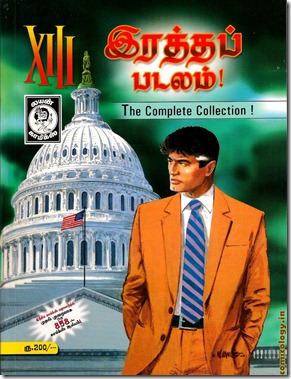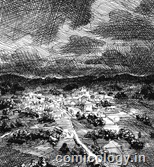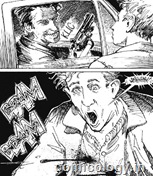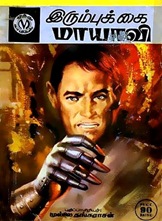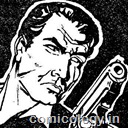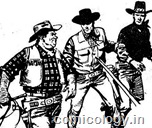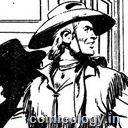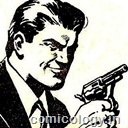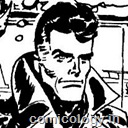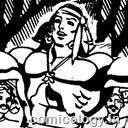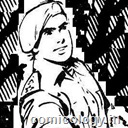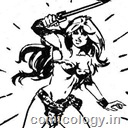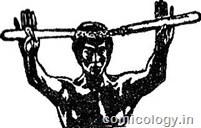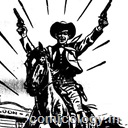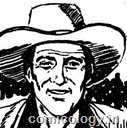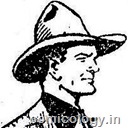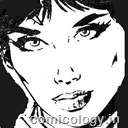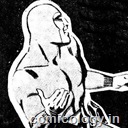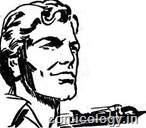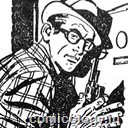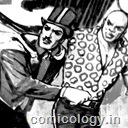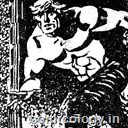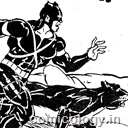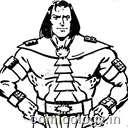All the election fever which was going around in the country for the last few months, have finally come to a sweet end, with India Inc. decisively voting in Elections 2009 for a stable government at the centre. Let’s hope that the momentum shows enough strength in revitalizing the economic fortunes of the country, which took a beating, undoubtedly, by the global financial slowdown.
 At Comicology, our recent post on Iznogoud with a complete account of his Indian presence, has garnered enough interest among comikers. Being an Iznogoud fan myself, there is no joy abound then sharing all the info about one of the famous antagonists in Comics, with like minded people.
At Comicology, our recent post on Iznogoud with a complete account of his Indian presence, has garnered enough interest among comikers. Being an Iznogoud fan myself, there is no joy abound then sharing all the info about one of the famous antagonists in Comics, with like minded people.
Rest assured that, with the list of Iznogoud titles published by Lion Comics, and the ones planned by
Euro Books and CineBook, may mean that this is only a start to the avalanche of posts reviewing the titles featuring this legendary Franco-Belgian comic character over here at Comicology. Stay Tuned, Comikers.
The topic for the current post, is a follow-up on the works of John Wagner, about whom we saw more during our Mehta Comics debut post, here.
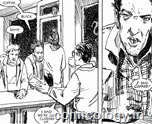 Without heeding to McKenna’s advice that he is closing, they demand their Coffee. The premonition of trouble, thrusts McKenna to wrap up his customers, and serve the duo before he brings down the shutters. McKenna was wise enough in deciding to send his daughter Ellie, to tag along with Bessy, for home bound.
Without heeding to McKenna’s advice that he is closing, they demand their Coffee. The premonition of trouble, thrusts McKenna to wrap up his customers, and serve the duo before he brings down the shutters. McKenna was wise enough in deciding to send his daughter Ellie, to tag along with Bessy, for home bound.
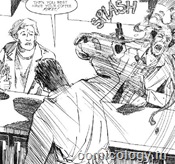 Having cornered McKenna alone, the duo threaten to deprive him off his life and money. Just when they thought that they have managed to make some free-lunch, they are shocked by the swift attacks McKenna manages to throw, in the process killing one and brutally injuring other.
Having cornered McKenna alone, the duo threaten to deprive him off his life and money. Just when they thought that they have managed to make some free-lunch, they are shocked by the swift attacks McKenna manages to throw, in the process killing one and brutally injuring other.
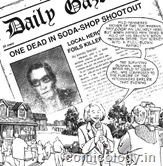 The next day, papers across country flash the news of the unlikely hero who courageously made his stand, helping to capture the mischief-makers. McKenna and his family suddenly receives huge fanfare and attraction. But McKenna is shown growing in concern, as he mysteriously starts fearing that the increased limelight may only bring more trouble.
The next day, papers across country flash the news of the unlikely hero who courageously made his stand, helping to capture the mischief-makers. McKenna and his family suddenly receives huge fanfare and attraction. But McKenna is shown growing in concern, as he mysteriously starts fearing that the increased limelight may only bring more trouble.
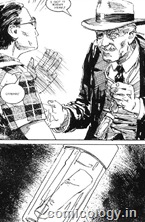 His fear turns to reality as the incident draws three more strangers to the isolated town, one of them an elderly man named Johnny Torrino. Dressed in Gentleman suits, the trio starts stalking McKenna and his family.
His fear turns to reality as the incident draws three more strangers to the isolated town, one of them an elderly man named Johnny Torrino. Dressed in Gentleman suits, the trio starts stalking McKenna and his family.
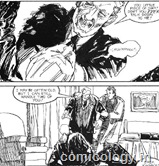 Torrino, who sports scarred face with an missing eye, confronts McKenna in his shop, quizzing about a long-lost kid from New York, named Joey Muni, who had left something with him: A cut finger, which hangs in a capsule on the neck of Torrino. A sight of which brings shivers down McKenna’s whole body. McKenna’s wife Edie, comes to help, as she quickly pushes out the trio, warning them of police action if they every trouble them again.
Torrino, who sports scarred face with an missing eye, confronts McKenna in his shop, quizzing about a long-lost kid from New York, named Joey Muni, who had left something with him: A cut finger, which hangs in a capsule on the neck of Torrino. A sight of which brings shivers down McKenna’s whole body. McKenna’s wife Edie, comes to help, as she quickly pushes out the trio, warning them of police action if they every trouble them again.
Back at their hideout, the trio confronts between themselves, as the younger sect believe that they mistook McKenna for someone else. But, they are soon silenced by the raging Torrino, 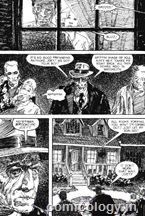 who seems to have more power than his deputy’s, even at his old age. Feared by his anger, the trio decide to follow McKenna, even setting aside the warning they get from the Sheriff of the locality.
who seems to have more power than his deputy’s, even at his old age. Feared by his anger, the trio decide to follow McKenna, even setting aside the warning they get from the Sheriff of the locality.
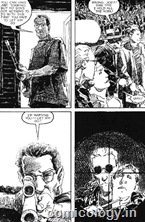 After a lot of run-down of frequent visits, and anonymous telephone threats, Torrino, finally consoles himself that he may have a mistaken in identifying his man. But just as they were making it back out of the town, Torrino encounters McKenna’s younger son, Frank.
After a lot of run-down of frequent visits, and anonymous telephone threats, Torrino, finally consoles himself that he may have a mistaken in identifying his man. But just as they were making it back out of the town, Torrino encounters McKenna’s younger son, Frank.
The resemblance of his face with his father’s, was enough for Torrino, to confirm his assumption, which sees him abducting Frank, and landing outside McKenna’s home. Torrino warns McKenna that he has finally found out his real identity, and it is time he comes out and gives himself up, or see his family massacred just before his eyes.
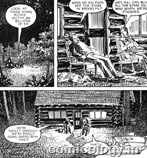 The resultant gun-shots and edge-of-the seat action, is sure to bring a chill running down your spine, as the Chapter 1: “A Small Town Killing” comes to a close on this Graphic Novel, which details how someone’s past life can come
The resultant gun-shots and edge-of-the seat action, is sure to bring a chill running down your spine, as the Chapter 1: “A Small Town Killing” comes to a close on this Graphic Novel, which details how someone’s past life can come 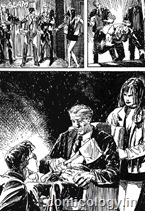 back to haunt him even if he desires to drive away from it. As they say, when you play and live life hard, then you have got to pay the price.
back to haunt him even if he desires to drive away from it. As they say, when you play and live life hard, then you have got to pay the price.
What did Joey do in his young age which has brought such hell to his new home, is detailed in the Chapter 2: “The Brooklyn Murders”, as it chronicles the life and trouble of two teenage friends, Joey and Richie who play hard, and use the shortcuts in life to earn quick money and fame, which sees them go separate ways.
After seeing that their is huge cash being circulated in the locality, Richie decides to steal some out from them, which was also to avenge his brother’s murder by the goons. Along with the reluctant Joey, the duo manage to make a run-down with local mobs, in a swift cloaked attack, and leave them bruised and killed, and having drained them of their booty, expectedly leaving them seeking for revenge.
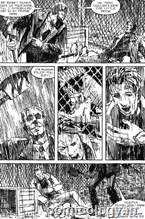 But, Richie’s attitude of flashing his money all over, draws the attention of the mob leaders in the locality, who hand-pick him for slaughter. The trails leads up to Joey, as he makes a run for his life, followed closely by the underground mobs.
But, Richie’s attitude of flashing his money all over, draws the attention of the mob leaders in the locality, who hand-pick him for slaughter. The trails leads up to Joey, as he makes a run for his life, followed closely by the underground mobs.
The scenes where he confronts Torrino, in an alley, and the resultant fight where he takes an eye-out of Torrino with a barb-wire, can’t be expressed in mere words. Incidentally, the talented artist did the same in those pages for us.
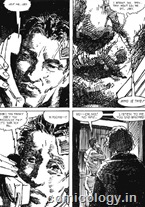 The life comes back to present day, as Joey now in his new life as Tom, tries to mend the evil seeds from his past, as he reappears in the city which changed his life for the worst, as Chapter 3: “With Evil Intent”, closes this 300 page epic Graphic Novel titled, aptly as A History of Violence, and carries the same weapons used significantly throughout the novel on its cover.
The life comes back to present day, as Joey now in his new life as Tom, tries to mend the evil seeds from his past, as he reappears in the city which changed his life for the worst, as Chapter 3: “With Evil Intent”, closes this 300 page epic Graphic Novel titled, aptly as A History of Violence, and carries the same weapons used significantly throughout the novel on its cover.
As witnessed throughout in the graphic novel, It has surprise twists at the end too, as Joey receives a chilling phone call from his supposedly murdered cohort Richie, and the last scenes where he encounters his worst nightmare, is one to take the readers to witness a whole new level of evil incarnation, which is an embodiment of a evil man’s inner self.
Overall, HOV is a Graphic Novel to remember for long, at least for me.
 John Wagner, who wrote “A History of Violence (HOV)” graphic novel, was eventually his first attempt to establish himself among the bigger league in American Comics Industry. He was ably assisted by Vince Locke, who with his unique line-artwork was able to recite the dark and noir nature of the graphic novel and its intrigued plot, a fact acknowledged by Wagner himself in his Preface on the Graphic Novel.
John Wagner, who wrote “A History of Violence (HOV)” graphic novel, was eventually his first attempt to establish himself among the bigger league in American Comics Industry. He was ably assisted by Vince Locke, who with his unique line-artwork was able to recite the dark and noir nature of the graphic novel and its intrigued plot, a fact acknowledged by Wagner himself in his Preface on the Graphic Novel.
 We have seen enough in detail about John Wagner, during our Monster review post over here, so let’s look briefly at the other creative genius behind this graphic novel, the American comic books artist, Vince Locke, whose expressive style of bringing the emotions of the characters in his artwork, formed a great combination along with Wagner’s writing style.
We have seen enough in detail about John Wagner, during our Monster review post over here, so let’s look briefly at the other creative genius behind this graphic novel, the American comic books artist, Vince Locke, whose expressive style of bringing the emotions of the characters in his artwork, formed a great combination along with Wagner’s writing style.
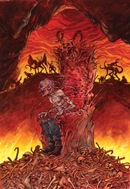 Locke came to in prominence in 1986 during his work as the artist for the underground hit series Deadworld, which was a zombie horror comic set in post-apocalyptic world. Though the series was short-lived due to frequent ownership changes, Locke was one of the main-stay, during which the series achieved a cult status.
Locke came to in prominence in 1986 during his work as the artist for the underground hit series Deadworld, which was a zombie horror comic set in post-apocalyptic world. Though the series was short-lived due to frequent ownership changes, Locke was one of the main-stay, during which the series achieved a cult status.
Buoyed by the success, Locke, soon contributed as an artist for the some of the famous comic series, including The Sandman, American Freak, Batman, Witchcraft, and eventually tagging along with Wagner in this memorable graphic novel, HOV.
You could read more about Locke’s work on his official site, who is currently busy with his artwork contribution to many a Role Playing Games (RPGs), an area where he would flourish for his noir-touch mixed artwork style, and a taste towards using watercolours heavily in his art-frames. Some of the images in his site was as scarry as it can get, for which a sample is given over here. So, it is not for the light-hearted :).
The idea of the Graphic Novel, HOV, came when Paradox Press Editor Andrew Helfer met Wagner in Scotland during a convention circa 1995. They have had prior stints of working together in various publications, before Helfer joined Paradox, which is a low-cost trade imprint of DC Comics, which was setup to concentrate on real-life stories, and drive away from the superhero theme adopted by DC.
So as per their established standard Helfer asked Wagner, to drive away from his Superhero works on 2000 AD series, and concentrate on providing something which involves Real stories with Real people. Wagner, accepted that challenge, and came up with an initial proposal which looked lot more similar to his other work on Button Man comic series. No need to say that Helfer rejected that concept, asking for more humanish characters.
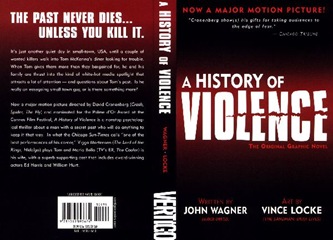 After another two years of hard-work, Wagner finally came back with the story which eventually found its place in History of Violence graphic novel, making it one of the memorable novels to hit the stands under Paradox Press brand.
After another two years of hard-work, Wagner finally came back with the story which eventually found its place in History of Violence graphic novel, making it one of the memorable novels to hit the stands under Paradox Press brand.
But, due to the low cost mantra, and content, Paradox never really achieved its due credit in the American market, which greatly affected the talented work of John Wagner to go places. Wagner is still restricted to his work on 2000 AD, with his works on his world famous creation, Judge Dredd.
But HOV, as stated before, was one of the best selling novels released by Paradox, so when Paradox was wounded up due to low sales, the series was reprinted in DC’s another trade imprint Vertigo. By this time, talks were on about making a movie based on the graphic novel, and when it was reprinted again, the covers widely published this news, as seen above. Also note the subtle change in the cover-art, to hide the suspense of the graphic novel, and leave it for the movie to open-up.
 A History of Violence (2005): It’s a premonition that not all great graphic novels get their due recognition, when adopted into mainstream movies, a fact agreed among many comics fans. But the 2005 movie, for which the central plot was adapted from the History of Violence graphic novel, sure deserves mention in our HOV review post here at Comicology.
A History of Violence (2005): It’s a premonition that not all great graphic novels get their due recognition, when adopted into mainstream movies, a fact agreed among many comics fans. But the 2005 movie, for which the central plot was adapted from the History of Violence graphic novel, sure deserves mention in our HOV review post here at Comicology.
The Movie was directed by David Cronenberg, and had a mega star cast like Viggo Mortensen (famous for his role as Aragorn in Lord of the Rings Trilogy, as Tom/Joey), Maria Bello (seen recently in Mummy 3, as Eddie),
Ed Harris (the multi-talented actor-director-writer as Torrino, or Carl Fogarty in the Movie), and William Hurt (as Richie), with all contributing equally to the success of the movie.
The Opening of the movie, with calmly looking duo, slowly moving past a Motel, leaving a blood trail, is sure to have caught the attention of all movie lovers. Especially considering that there was no background score for more than 5 minutes from the start during this scene enactment.
More importantly Ed Harris’s still and scary slow-paced acting (he was undoubtedly the perfect choice for graphic novel’s Torrino’s character), and Mortensen’s renditions of a frightened man trying to save his present being haunted by his past. Bello’s acting ably assists in bringing out the character of a worrying and supporting wife through his husband’s struggle to take control of his sagging life.
The scenes were Harris and his goons, stalk Mortensen’s family were shot with a unique blend of suspense and thrill, which is sure to bring many a comic fan’s dream of seeing a movie made out of a graphic novel with all its essence, maintained at the same level as the Original. Top of the pick is the shopping-mall and house invasion scenes.
Cronenberg was the right choice to direct this venture, as he has the speciality to make movies with themes ranging in the darker aspects of human emotions and behaviours (who can forget the Sci-Fi movie, The Fly), and the plot of HOV was virtually his playground. Josh Olsen who adapted the Screenplay based on the Novel, also contributed to twists and scenario changes to make the movie interesting and packed for the 80 Minutes run-time, meaning it was meant to cut the past reciting witnessed in Chapter 2 of the Graphic Novel.
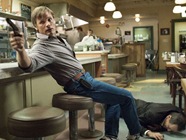 It should not be forgotten, that the success of the movie also derives heavily from the reciting of Wagner and Locke in their graphic novel, which contributed heavily to the screenplay in many parts of the movie, which propelled it to a blockbuster of success, and landing William Hurt and Josh Olsen for Oscar award nominations as the Best Supporting Actor, and Best Adapted Screenplay, respectively.
It should not be forgotten, that the success of the movie also derives heavily from the reciting of Wagner and Locke in their graphic novel, which contributed heavily to the screenplay in many parts of the movie, which propelled it to a blockbuster of success, and landing William Hurt and Josh Olsen for Oscar award nominations as the Best Supporting Actor, and Best Adapted Screenplay, respectively.
Eventhough, the movie at many its places moves through the mum-scene way of story-telling, there were instances of genius in dialogues, when an opportunity was available. Two of the areas, which I felt touched where:
When, confronting with his son, who just broke out of a fist-fight at school
Tom: In this family, we do not solve our problems by hitting people!
Jack: No, in this family, we shoot them!
When, an irate Eddie after knowing of Tom's past life, quizzes about the choice of his last name - Stall
Tony: It was available.
Eddie: I guess I was available, too.
The climax of the movie is altered from its Graphic Novel counterpart, as that scene was too a risky proposition to have passed through movie censorship (if at all, there is one such in United States :)). But, looking at it from the movie point of view, the climax looked like a better fit. The movie ends with a silent dinner scene involving Tom’s family, which leaves viewers to diffuse whether they stayed together or not, after all that has gone through. All credit goes to the director and screenplay writer, for delivering such a power-packed movie.
 Apart from that, there were little-over dose of sexual romance scenes of Mortensen and Bello, which could have been avoided. But hey, aren’t we talking about a Hollywood movie? so it is well within expectations, as many would agree :). Not a movie to watch with your family for sure :).
Apart from that, there were little-over dose of sexual romance scenes of Mortensen and Bello, which could have been avoided. But hey, aren’t we talking about a Hollywood movie? so it is well within expectations, as many would agree :). Not a movie to watch with your family for sure :).
Thus we come to the end of another review post, which featured one of the unique Graphic Novels I read in recent times. Thanks mainly to the Back-Issue title release, as a result of Paradox’s closure, through which this particular issue was available in India at a throw-away price. I wouldn’t have spent $10 to buy this comic for sure :).
Also to be noted here, that I should admit that, “Lover of Dreams” Shankar Visvalingam’s recent review post (in Tamil) on a graphic novel titled, From Hell, which was based on the notorious Jack the Ripper character; was instrumental in me getting down to read through this novel. The reason, I generally despise those comics, which have a noir style of artwork, but still doesn’t classify in the standards laid out in the present comics world.
But Shankar’s post made me realize that artwork has to more importantly resemble the plot for which it is drawn, yet maintaining a style of its own, and in that way A History of Violence was truly up-to-the mark.
With that note, I will conclude this post, and would be eager to read your comments on the graphic novel, and this review post in whole. And by the way, if you get a chance, to grab this copy, do not miss the opportunity to own an item which certainly deserves to be there in your collection. Have a Great and Enjoyable Weekend, Comikers. Adios Amigos !



